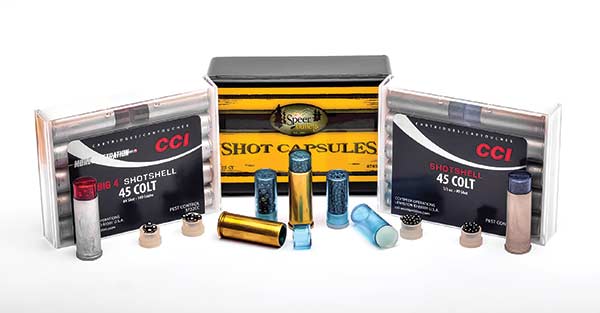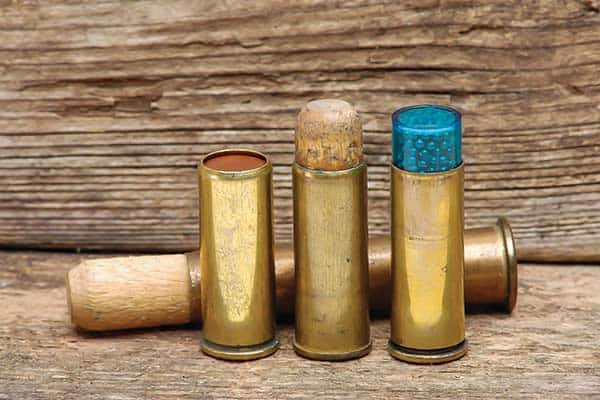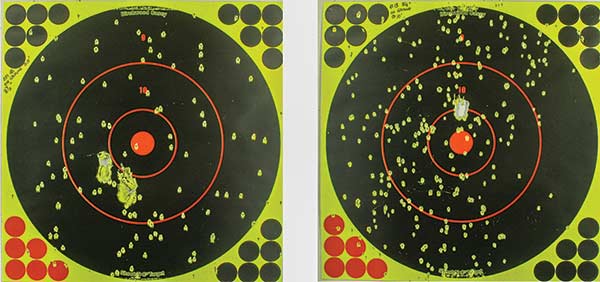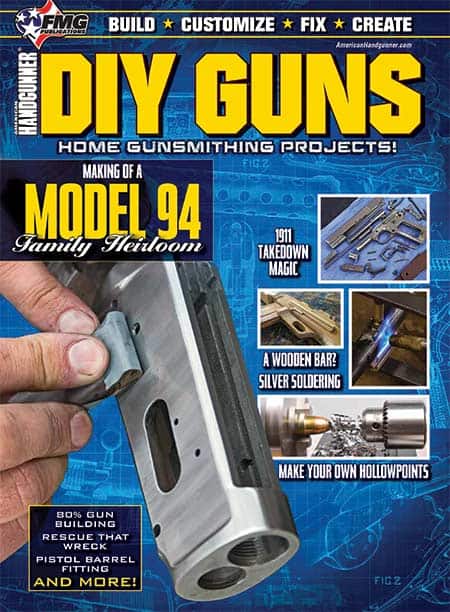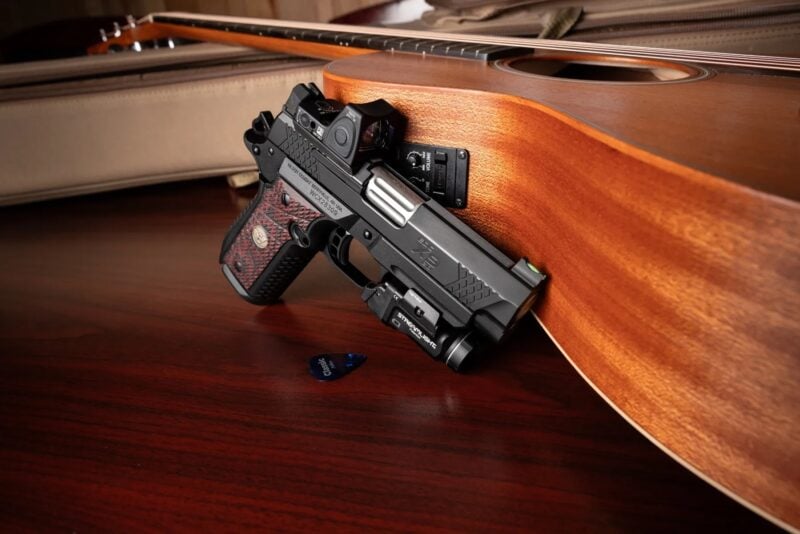Snake Medicine
How to Make .45 Colt Shotshells
When I recently decided I needed (okay, wanted) some CCI .45 Colt shotshells, I was shocked at the price of $1.60 per cartridge! I recovered enough to cough up the dough for a few of the traditional ones loaded with #9 shot, plus some of their new Big #4 shot versions.
However, I’m a crafty cheapskate reloader. While I was shopping, I also found some of those Speer blue plastic shot capsules for 18 cents each. Why couldn’t I make my own?
The cost savings would be compelling, and another benefit of loading your own is being able to choose your own shot size. The standard load of 140 grains of #9s in the factory CCI load figures out to about 186 pellets, and the Big #4 load in .45 Colt only contains 40. Number 6 shot has long been regarded as an excellent bunny popper and pheasant dropper. Why not a load of 75 of those pellets? Or 120–140 of clay pigeon-busting #7-1/2s or 8s?
Do keep in mind rifled barrels are famous for scattering shot like mad, limiting effective range to a maximum of about 15′. I did my testing at 10′. In Speer’s Handloading Manual Number 15, they caution the higher the velocity, the faster the shot spreads out. Photos of the targets comparing loads using 7.5 grains of Unique at an advertised 975 fps and 5.5 grains of Bullseye at 875 fps illustrate this quite clearly.
Shot Supply
It’s easy enough to open some inexpensive shotgun shells for their shot. A box of 25 1-oz. loads will make about 70 .45 Colt shotshells. It sure beats buying a 25-lb. bag of shot just to experiment. Alternatively, shot in sizes 10, 11 and 12 is available in 10-lb. bags for just under 40 bucks from Midway USA and Ballistic Products.
I chose to start out with #12 shot. The rationale being, if 31 grains of #12 in a .22 LR or 52 grains in a .22 WMR are sold as bad medicine for mice and snakes, why not 155 grains of them coming out of my .45? Think about a whole cloud of more than 800 pellets, compared to about 163 from a .22 LR and 273 from a .22 WMR. I think the targets shown will confirm my theory.

Left, a 0.475" O.D. with six grains of Unique topped with a Hornady
.44-caliber gas check, cup side up, and 180 grains of #12 shot.
Needle-nose tweezers help seat the check. Center, a Hornady .45-caliber
gas check squeezed down to 0.452" in a Lee bullet sizing die on top of the shot.
Right, a roll crimp holds everything in place.
Who Needs Shot Cups?
But what if you can’t get your hands on either factory loads or Speer capsules? As Speer says, “Historically, making handgun shotshells for close-range pest control was usually more trouble than it was worth. Loading the various components was tedious, and the resulting ammo usually performed poorly.” To which I can only say “Amen.”
For me, the first requirement is the load not lose its shot while riding in a cylinder otherwise full of standard-power cartridges. Some like to load shot in the first one or two chambers ready to be fired, then just rotate past them if they choose to shoot bullets first instead of shot. A shot cartridge must be able to withstand firing five rounds of bullets without spilling its guts. CCI factory cartridges can do this with ease.
I spent several days spilling powder and shot, trying various components, wrecking perfectly good cases and creating loads that vomited when I shot 255-grain lead bullets.

Left, Speer shot capsule with 155.6 grains #12 shot, 7.5 grains Unique.
Advertised velocity 975 fps. Center, same as target at left with 5.5 grains
of Bullseye. Advertised velocity 875 fps. Right, Roger’s Lucky #13 load.
All targets at 10' using Ruger Blackhawk with 4-5/8" barrel. More velocity
results in larger shot patterns.
Solution? Gas Checks!
The solution lies in using copper gas checks for over-powder and over-shot cards, but there’s a hitch. Gas checks for .45 Colt are 0.460″ diameter. Brand-new factory brass is usually 0.474″ outside diameter, meaning about 0.454″ inside at the mouth and then tapering still smaller toward the base of the case as it thickens inside. So how can it work? The secrets are to use a 0.439″-diameter .44-caliber gas check for the over-powder card, and to push those 0.460″ gas checks through a Lee 0.452″ bullet sizer for the overshot cards.
Grins finally arrived on the scene with Load #13. It consists of using fired cases trimmed to 1.270″ and resized in a die leaving them 0.475″ in diameter, then generously neck flared. Power comes from six grains of Unique topped with the .44 gas check, cup side up. Using 180 grains of #12 shot leaves a 0.452″ gas check 0.035–0.040″ below the top of the flared case mouth, cup side down. This ensures crimping doesn’t compress the powder charge, which is dangerous with pistol powders.
Use a roll crimp to hold everything in place. I’ve found setting the crimp to reduce the case mouth size to 0.405–0.410″ works fine. A faint shot rattle assures me I haven’t compressed the powder charge. To me, it’s the nearly perfect homemade .45 Colt shotshell. The imperfection is I’m probably going to get significant barrel leading from the soft lead shot. However, Kano Kroil does do an excellent job of floating that stuff loose.
The Easy Life
My advice? When you finally get lucky and find some Speer shot capsules in stock somewhere, just buy a lifetime supply and be done with it. The capsules are inexpensive, easy to use and don’t lead the barrel. They’re undersized, however, so sizing your cases in a die that squeezes them down to the 0.468″ (RCBS Cowboy) to 0.470″ (Lee) diameter range will reduce capsule slippage and make accurate seating easier.
Fill the capsules with whatever you prefer and use the Speer-recommended charge of 5.5 grains of Bullseye. The only way I know of to obtain sufficient roll crimp to keep them in place is to increase the crimp on one until it breaks. Then back your crimping die off a quarter to no more than half a turn to make the rest of them.
Homemades like mine are more fiddly diddly to make than using the capsules. Then again, they do shoot well; nothing breaks and spills shot while loading them and they hold 15% more #12 shot than the capsules. You can always make up some of each and see which you prefer.
I’m still comparing and thinking, because they’re both so good I probably never will come to a conclusion.

